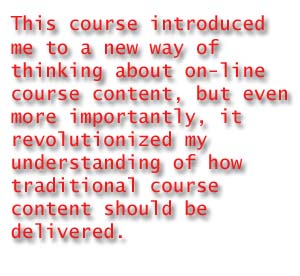 |
Evidence of Analytical and Integrative Thinking
Fall Semester, 2003
EDCI 797a - Merging the Content Curriculum and Technology
There is a steep learning curve for teachers who want to develop on-line course curricula. Teachers must become efficient on-line learners before they can ask students to become such. Teachers must become familiar with the tools of on-line learning such as the web page, the chat room, and email. Once these tools have been mastered, then they can embark on turning what they know about their content are into a living, breathing on-line course.
I have been developing on-line content since 1994. Ever since I became aware of the academic applications of the Internet, I have continued to develop my skills so that students and teachers could take advantage of the content I made available to all. Until now, I had no paradigm for doing so. If I did have a paradigm, it was a haphazard, incoherent methodology where paper lesson plans were turned into hyperlinked lessons that teachers could view. Students could use the on-line content for information or practice, but there was little or no depth to what I posted on-line.
|
This course introduced me to a new way of thinking about on-line course content, but even more importantly, it revolutionized my understanding of how traditional course content should be delivered. In this course, students became familiar with the idea of the "authentic activity." In the form of the "challenge" students are asked to pretend that they are engaging in some meaningful activity, most likely some sort of occupational application of the academic course content and state standards that all students are required to master. In effect, students take on roles and tasks that they might actually have to perform in real life sometime in the future. Once exposed to this activity, students will be more motivated to investigate the topic at hand because it has a greater relevance to their lives. Students would then begin using the Internet and tradition off-line resources such as the trusty textbook in order to complete the authentic activity. Teacher, in the form of on-line "mentors," would guide the students through each step of the process, from topic acquisition to concept mastery. The mentor-student relationship must become a central component to learning and teaching on-line, and both must learn new skills in order to make the best use of the new toolkit at each other's disposal. |
One unit of study for any on-line course is called a module. Each course is broken up into a number of modules, usually more than ten but no more than fifteen. Students are given the challenge, which is the culminating project that requires research and information-gathering to be sufficiently completed. In order to achieve the goals of the challenge, students must conduct research into the background of the tropic. They were able to construct enough data to achieve the goals of the challenge by completing two to four "background building" activities. Students were able to achieve the highest level of performance through their own self-regulation, which involves motivation (gotta wanna) and self-remediation (did I do it right?). The teacher must provide a rubric for the student to see whether or not the goals of the challenge have been achieved. The student should use the rubric as a guide for completing the activities fully, leading to the greatest academic achievement.